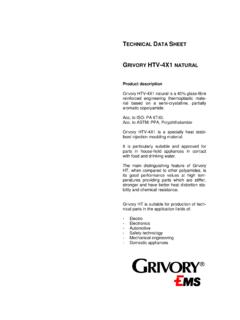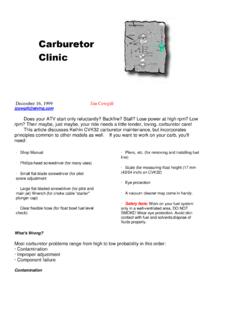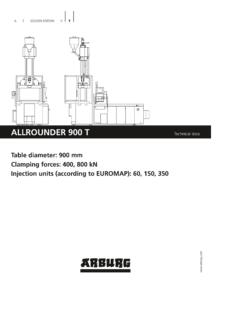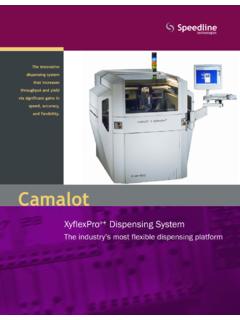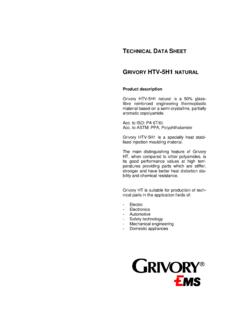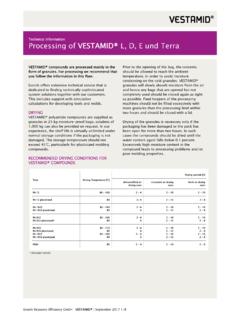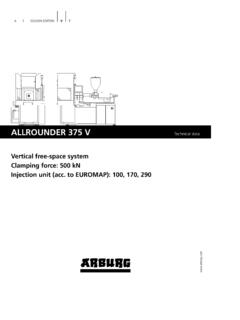Transcription of TR 55 LX E - kphuaxun.com
1 TECHNICAL DATA SHEET. GRILAMID TR 55 LX. Product description Grilamid TR grades are transparent thermo- plastic polyamides based on aliphatic and cycloaliphatic blocks. Grilamid TR 55 LX. offers a variety of interesting properties such as: clear transparency even in high wall thicknesses good light natural colour can be coloured in transparent as well as opaque colours tough stiff good chemical- and stress-crack resis- tance Grilamid TR grades are suitable for produc- tion of optical and technical demanding parts in the application fields of: - Optic - Electro / Electronics - Automotive - Mechanical engineering - Domestic appliances - Sanitary PROPERTIES. Mechanical Properties Norm Unit State Grilamid TR 55 LX. Tensile E-Modulus 1 mm/min ISO 527 MPa cond. 1900. Tensile strength at yield 50 mm/min ISO 527 MPa cond. 70. Elongation at yield 50 mm/min ISO 527 % cond.
2 6. Tensile strength at break 50 mm/min ISO 527 MPa cond. 40. Elongation at break 50 mm/min ISO 527 % cond. > 50. Impact strength Charpy, 23 C ISO 179/1eU kJ/m cond. > 100. Impact strength Charpy, -30 C ISO 179/1eU kJ/m cond. > 100. Notched impact strength Charpy, 23 C ISO 179/1eA kJ/m cond. 9. Notched impact strength Charpy, -30 C ISO 179/1eA kJ/m cond. 8. Ball indentation hardness ISO 2039-1 MPa cond. 110. Thermal Properties Glass transition temperatures DSC ISO 11357 C dry 110. Heat deflection temperature HDT/A MPa ISO 75 C dry 80. Heat deflection temperature HDT/C MPa ISO 75 C dry 90. -4. Thermal expansion coefficient long. 23-55 C ISO 11359 10 /K dry -4. Thermal expansion coefficient trans. 23-55 C ISO 11359 10 /K dry Maximum usage temperature long term ISO 2578 C dry 80. Maximum usage temperature short term ISO 2578 C dry 95. Electrical Properties Dielectric strength IEC 60243-1 kV/mm cond.
3 32. Comparative tracking index CTI IEC 60112 - cond. 600. 11. Specific volume resistivity IEC 60093 m cond. 10. 12. Specific surface resistivity IEC 60093 cond. 10. General Properties Density ISO 1183 g/cm dry Flammability (UL94) mm ISO 1210 rating - HB. Water absorption 23 C/sat. ISO 62 % - Moisture absorption 23 C/50% ISO 62 % - 1. Linear mould shrinkage long. ISO 294 % dry Linear mould shrinkage trans. ISO 294 % dry Product-nomenclature acc. ISO 1874: PA 12/MACMI + PA 12, GHLT, 14-020. 2. Processing information for the injection moulding of Grilamid TR 55 LX. This technical data sheet for Grilamid TR 55 LX Silver streaks can also be caused by provides you with useful information on material preparation, machine requirements, tooling and ! overheating of the material (over 320 C). or by too long melt residence time in the processing. barrel. Drying temperature MATERIAL PREPARATION Polyamides are affected by oxidation at tempera- tures above 80 C in the presence of oxygen.
4 Visible Grilamid TR 55 LX is delivered dry and ready for yellowing of the material is an indication of oxida- processing in sealed air tight packaging. Predrying tion. Hence, temperatures above 80 C for desiccant is not necessary. dryers and temperatures above 100 C for vacuum ovens should be avoided. In order to detect oxida- tion it is advised to keep a small amount of granu- Storage late (light colours only !) as a comparison sample. Amorphous polyamides can be stored over years without negatively influencing it's mechanical prop- At longer residence times (over 1 hour) hopper erties. However, in order to ensure optimal colour heating or hopper dryer (80 C) is useful. and transparency, Grilamid should not be stored for more then 12 months. At temperatures above 25 C. in combination with long storage temperatures, the Use of regrind oxidation saturation process of the granulate is Grilamid TR 55 LX is a thermoplastic material.
5 Accelerated. Hence, it is advised to keep storage Hence, incomplete mouldings as well as sprues and temperatures below 25 C. The above mentioned runners can be reprocessed. The following points effect becomes only visible after injection moulding should be observed: and shows itself in pats which have a more yellow appearance. Storage facilities must be dry and Moisture absorption protect the bags from the influence of weather and Grinding: Dust particles and particle size distri- damage. bution Contamination through foreign material, dust, Handling and safety oil, etc. Detailed information can be obtained from the Level of addition to original material Material Safety Data Sheet (MSDS) which can be Colour variation requested with every material order. Reduction of mechanical properties Drying When adding regrind, special care has to be taken Grilamid TR 55 LX is dried and packed with a by the moulder.
6 Moisture content of less than %. Should the packaging become damaged or be left open too long, then the material must be dried. A too high MACHINE REQUIREMENTS. moisture content can be shown by a foaming melt, excessive nozzle drool and silver streaks on the Grilamid TR 55 LX can be processed economically moulded part. and without problems on all machines suitable for polyamides. Drying can be done as follows: Screw Desiccant dryer Wear protected, universal screws with shut-off nozzles are recommended (3 zones). Temperature: max. 80 C. Time: 4 - 6 hours Screw Dew point of the dryer: -30 C. Length: 18 D - 22 D. Compression ratio: 2 - Vacuum oven Temperature: max. 80 C Shot volume Time: 4 - 8 hours The metering stroke (less decompression distance). must be longer than the length of the non-return- Drying time valve. If there is only little evidence of foaming of the melt or just slight silver streaks on the part, then the above mentioned minimal drying time will be suffi- Selecting the injection unit cient.
7 If material is stored open for days, shows Shot volume = - x strong foaming, unusually easy flow, streaks or a (max. shot volume of injection unit). rough surface on the moulded part, then the maxi- mum drying time is required. 3. Heating PROCESSING. At least three separately controllable heating zones, capable of reaching cylinder temperatures Mould filling, post pressure and dosing up to 350 C. Separate nozzle heating is neces- The injection speed should be regulated so as to sary. The cylinder flange temperature must be reduce towards the end of the filling cycle in order controllable (cooling). to avoid burning. For dosing at low screw revolu- tions and pressure the cooling time should be fully nozzle utilised. Open nozzles are simple, allow an easy melt flow and are long lasting. There is however, the danger Basic machine settings that during retraction of the screws following injec- In order to start up the machine for processing Gri- tion of the melt, air maybe drawn into the barrel lamid TR 55 LX, the following basic settings can be (decompression).
8 For this reason, needle shut-off recommended. nozzles are often used. Temperatures Clamping force As a rule of thumb the clamping force can be esti- Flange 40 C. mated using the following formula: Zone 1 240 C. Clamping force Zone 2 245 C. Zone 3 250 C. 1). kN x projected area (cm ). 2 nozzle 245 C. Tool 40 C. 1). for a cavity pressure of 750 bar Melt 265 C. TOOLING. The design of the mould tool should follow the Pressures / Speeds general rules for transparent thermoplastics. Injection speed middle - high For the mould cavities common mould tool steel Hold-on pressure (spec.) 300 - 600 bar quality ( hardened steel) which has been hard- Dynamic pressure (hydr.) 5 - 10 bar -1. ened to a level of 56 HRC is recommended. Screw speed 50 - 100 min Venting In order to prevent burning marks and improve weldline strength, proper venting of the mould cav- CUSTOMER SERVICES.
9 Ity should be provided (venting channels on the parting surface dimensions: Depth mm, width EMS-GRIVORY is a specialist in polyamide synthe- 2 - 5 mm). sis and the processing of these materials. Our cus- tomer services are not only concerned with the Gate and runner manufacturing and supply of engineering thermo- To achieve the best mould filling and avoid sink plastics but also provide full technical support in- marks, a central gate at the thickest section of the cluding: moulding is recommended. Pin point (direct) or tunnel gates are more economical and more com- Rheological design calculation / FEA. mon with technical moulding. Prototype tooling Material selection To avoid premature solidification of the melt and Processing support difficult mould filling, the following points should be Mould and component design considered: We are happy to advise you.
10 Simply call one of our Gate diameter sales offices. x thickest wall section of the injection moulding part Runner diameter The recommendations and data given are based on our x thickest wall section of the injection experience to date, however, no liability can be assumed moulding part (but minimum 4 mm) in connection with their usage and processing. 4.


